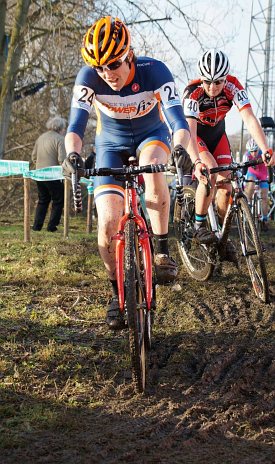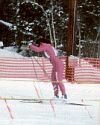Belgium Adventure 2014-15: Introduction
Introduction
Here's the quick introduction, if you don't already know me. I grew up ski racing, won the Maine State Champs as a high schooler, and came to Minnesota to attend St. Olaf. As a post-collegiate athlete, I raced for Alpina Madshus, earning a top-20 in the Birkie, and winning the Mora Vasaloppet classic twice. In 2006, life circumstances forced me to step away from serious ski racing, and get a job! At the same time, I discovered cycling.
Nowadays, I work full-time as a Project Manager at Data Recognition Corporation in Maple Grove, while I train and race cyclocross nationally. It's a balancing act to say the least. I spend many fall weekends dragging a bike and a laptop across the airports.
Belgium--The Motherland of Cyclocross
This is my second trip to Belgium over Kerstperiode (the Christmas racing period). While cyclocross is an esoteric minor sport in the U.S., it's a major spectator sport in Belgium. Last year's CX World Championships got 76% of the television viewership in Belgium. (For comparison, the 2014 Super Bowl drew just 46% of U.S. Viewership. Belgians (particularly those living in the Flanders region) are rabid fans: families come out to stand in the mud and cheer on their heros, and events are riotous, with lots of beer, smoking, and frites (french fries). Kerstperiod (Christmas period) has two World Cups and three UCI (international) races between December 21 and January 1. I'll be racing in one local race, three UCI races in Belgium, and a fourth UCI in the Netherlands.
Preparation
This cyclocross season has not been the easiest on for me. I had a tremendous summer of training, competing in a number of high level road races: North Star Grand Prix, Tour of America's Dairyland, and Green Mountain Stage Race (GMSR). GMSR was meant to be my final big racing block prior to the cyclocross season. However, on stage two, I crashed in the field sprint and got hit from behind, breaking two ribs. The timing was not so hot. It was just three weeks until my first cyclocross race of the season.
Cyclists are tough. It's possible to ride through broken ribs, which I did. I spent two weeks on the rollers, where I put in quality workouts, but was safe from falling. These weren't the greatest times of my life. Training hurt, quite a lot, I was tired all the time, and I was filled with doubts. Coming back to racing wasn't the easiest either, as my early season performances were below par. Fortunately, I am the beneficiary of an excellent coaching situation. My coach, Larry Foss of The Fix Studio, slowly and patiently helped me find my form and confidence. My season would have ended, or at least fizzled out, prematurely if it were not for him.
Now, three months later, I am in a very different place.
I've had some solid results, earned some UCI points, qualified for the elite National Championships, and the workouts that I've done at the Fix demonstrate that I am in the best shape of my life. I did have a scare just last weekend when I crashed and bruised some ribs. I got chiropractic care, massage, and used a ton of ice and Tens. I taped, dosed myself up on Alleve, and kept to the rollers. Last Monday, I could not roll over in bed, but at the moment, I'm back to 100%. Deep sigh of relief--bruised ribs heal much more quickly than broken ones!
Second Chances

You may have followed my Belgium exploits last year on Skinnyski. It was a tremendous and overwhelming learning experience with some misadventures along the way.
The most important change between this year and last is that I have hired a Belgian mechanic. Mechanics are great the world over, but perhaps never so needed as in Belgium. Belgium, this time of year, is mud: bogs of incomprehensible, drivetrain-destroying mud. Most days, one could not complete the race on a single bike. Pitting onto a new bike 1-2 times a lap is the norm, and the world's best riders have 3+ bikes available to them in a race. On race day, I will pre-ride, covering my bike in mud, and then hand it to the mechanic to clean while I warm-up on the other. Mid race, he'll handle bike changes and cleaning. After the race, he'll clean the bikes lightly at the venue and then clean, repair, re-lube in the evenings at home. Last year, my husband Michael and I handled all this. I spent way too many evenings standing outside in the dark and rain cleaning my bike. While I'm not afraid of hard work, it's easy to understand that with five races in ten days, there is an energy cost!
How do you Hire a Mechanic in Belgium?
I've been asked that several times. Facebook has made for a whole new world. I reached out to American riders based in Belgium or who have traveled to race there. Ultimately, I acted on a positive recommendation from an acquaintance, and worked out the details via Facebook Messenger.
Not unrelated, before even leaving Minneapolis, I had a fan contact me via Facebook Messenger and request and rider card. Sweet. Too bad, I didn't have any made!
(Rider cards are postcard-sized player cards, like baseball cards. I don't fancy myself "good enough" for such a thing, but in Belgium, there are some fans who are VERY serious about collecting a card for every rider on the program.)
Equipment Transport
Cyclocross racing requires traveling with a lot of equipment. With me, I have two bikes, a trainer, and a trainer wheel.
Each bike is in a Gavilan BFF bike bag. (In the interest of full disclosure, I am NOT sponsored by Gavilan and I paid retail for them.) They are only very slightly above the standard baggage size, and I've never exceeded 50 pounds despite stuffing them full. They have made airline travel and economy rental cars doable. Given their small size, I do need to remove the fork, but that only takes a few minutes more.
My trainer and a rear wheel with road tires are packed in a wheel bag. My trainer, also a non-sponsorship, retail purchase, is a Minoura. At home, I ride rollers, so the Minoura devoted exclusively to travel. I got it because it's the smallest and lightest in the industry. Yup, it's a little flimsy for daily use, but has plenty of resistance for even the hardest openers and warm-ups.
Why take a trainer and a wheel all the way to Europe? I'm a pretty big believer in trainers for warm-up year-round, as they allow me to do the precise power-based warm-up that works for me. However, by late cyclocross season, a trainer becomes all the more critical. Doing a quality warm-up in cold weather on wet roads just is not feasible. If I had more ties in Belgium, I might be able to find a trainer and wheel to borrow, but.....
Follow me
I'm looking forward to writing a series of pieces on my trip for Skinnyski. My hope is not only to capture the sights and sounds of cyclocross in Belgium, but shine a light on what it takes to race in Europe without the support of a professional team.
 | About the author... Corey Coogan Cisek has been competing in one sport or another for all her life, first alpine skiing, then Nordic, and now bike racing. She balances full-time work as a Project Manager with traveling the country on weekends to race USA Cycling Pro Cyclocross calendar events. Cisek is coached by The Fix Studio in Minneapolis and rides for PowerFix Elite CX Team. |

